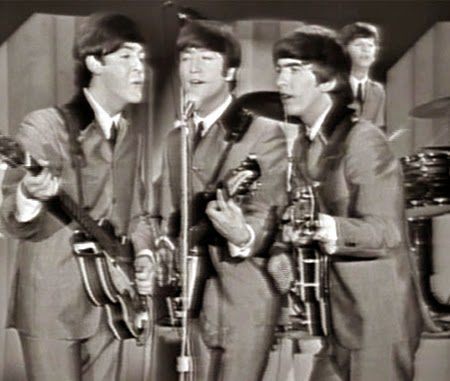The Story:
This song was recorded very early on in album sessions, first only meant to be recorded as "album filler" for the Beatles follow up album, not really considered a single. When it was broadcast for the first time on Britain's "Top of the Pops", a popular BBC show hosted by David Jacobs, the potential of this song was realized due to the fan response.
It eventually became a Beatles classic, and in fact, was used as the opener for the Beatles first appearance on the Ed Sullivan Show in 1964.
The song was nearly always included in Beatles concert set lists and often played live during Paul McCartney's solo career. When performed by the Beatles, George sang the harmonies in the 3rd verse (originally triple tracked by Paul in the studio).
Interesting: Although this song was in fact Paul's composition -- in 2005 Cynthia Lennon wrote that she believes that the song was written by John for her (it was not).
Songwriting:
"All My Loving" was conceived sometime between May 18 and June 9, 1963 while the Beatles were on their 3rd national tour with Roy Orbison. According to Paul he wrote the lyrics on the bus - "it was the first song where I wrote the words without the tune" - and those lyrics were inspired by actress Jane Asher, whom Paul met a month earlier on April 18, 1963.
"All My Loving" was one of the earliest rock and roll songs in which the lyrics were written in the form of a poem, which eventually became a fairly normal practice, or at least a viable writing option for many singer/songwriter teams.
According to John Lennon -- "'All My Loving' is Paul, I regret to say. Ha ha ha. Because it's a damn good piece of work...but I play a pretty mean guitar in the back." With this song, John really discovered the individual songwriting talent of Paul McCartney as an inspiring competitive force to be reckoned with when it came to writing singles.
Studio Date:
July 30, 1963
Location:
Abbey Road Studios, London, Studio Two
Songwriting Credit:
John Lennon/Paul McCartney
Personnel:
John Lennon/Paul McCartney
Personnel:
John Lennon -- Backing Vocals, Rhythm Guitar
George Harrison -- Backing Vocals, Lead Guitar
Paul McCartney -- Vocal, Bass Guitar
Ringo Starr -- Drums
Technical:
Producer: -- George Martin
Engineer: -- Norman Smith
Asst. Engineers: -- Geoff Emerick, Richard Langham
Instruments:
The Beatles relied on using their stage gear for this recording:
John Lennon -- 1958 Rickenbacker 325 Capri
George Harrison -- Gretsch Country Gentleman
Paul McCartney -- Höfner model 500/1 "violin" bass
The Beatles relied on using their stage gear for this recording:
John Lennon -- 1958 Rickenbacker 325 Capri
George Harrison -- Gretsch Country Gentleman
Paul McCartney -- Höfner model 500/1 "violin" bass
Recording Legacy/Recording Innovation:
As the Beatles became more comfortable in the studio, they began to challenge the engineering team to use available technology to get the exact sound they wanted. For this piece:
-Paul double tracked his own voice (you can easily hear this at 0:27 at "kissing" and also at 0:35 on "will come true".
-Paul triple tracked his own voice for harmonies in the 3rd verse.
-John's skill at rhythm guitar began to emerge - his backing rhythm guitar was in triplets, reminiscent of the Crystals "Da Doo Ron Ron" - "A superb piece of guitar" as John said himself.
-George used his Gretsch Country Gentleman to play one of his first excellent Chet Atkins style solo's that used prolifically in the early days.
Listen:
Included below is the studio version, stereo remastered, as well as the Ed Sullivan premier - the first glimpse of the Beatles live in America!










